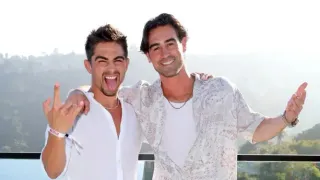August 16, 2014
Out There :: Lifetime Achievement
Kilian Melloy READ TIME: 4 MIN.
Undoubtedly the big art-house movie of the summer has been writer-director Richard Linklater's extraordinary "Boyhood," which opened in July. Though the film was showing in three screening rooms at the Embarcadero Center Cinema one weeknight last week, it played to an almost-full house when Out There saw it, and a later showing was already sold out. Word is clearly out.
What's revolutionary about the movie is that it tells the story of one boy's transition from 6 to 17 years old, and Linklater actually shot it in increments over the course of 12 years, so that his cast ages naturally, you might even say in "real time." Mason Jr. (Ellar Coltrane) goes from cherubic first-grader to college freshman in three hours, and we see that the child really is the father of the man. Linklater apparently has an eye for movie stars, as Coltrane grows steadily into leading-man good looks. Ethan Hawke and Patricia Arquette are convincing and dedicated as Mason's estranged parents; their looks really change as well, from young adult beauty to middle-aged spread. And Lorelei Linklater is spot-on as Ethan's older sister, aging from little girl to awkward tween to confident teen.
"Boyhood"'s mundane setting (various Texas cities) and plot (life's imperfect trajectories) mask a rather cosmic achievement in cinema. If Terrence Malick's "The Tree of Life" (2011) used suburban American life as the basis for a meditation on the cosmos, Linklater's Middle American film is at heart an artistic statement about time, and its effects on us all. In other three-hour movies, it's often the audience that feels as if it's aged 12 years. Not so here. Slice of life? "Boyhood" gives you the whole pie.
Code Red
Out There was in the house as San Francisco Playhouse's Sandbox Series presented the world premiere of playwright Rhett Rossi's "From Red to Black," directed by Susi Damilano, at the ACT Costume Shop. This series of plays given stripped-down productions in a black-box theater is intended to create an intermediate space between workshopped readings and fully staged runs, and up-and-coming stage scribe Rossi's urban tale fills the bill of fare quite well.
Two NYPD detectives investigate the suspicious death of a man who fell onto subway tracks in front of an oncoming train. They bring a young black man who was at the scene in for questioning - the kind of youth, as one policeman notes, who was sentenced before he was even born. The play raises questions of police misconduct, coercive confession, the criminal justice system's treatment of the underclass, and other contemporary issues, but it doesn't feel like an "issue play," it feels like drama. There's even an important "gangle" (gay angle) involved, but it unfolds naturally as part of the plot, so it won't be given up here.
The cast - Matthew Baldiga and Charles Shaw Robinson convincing as hard-bitten cops of different generations, Isiah Thompson excellent as the brother from the projects, and Michael Shipley solid as the deceased's work associate - is uniformly strong. SF Playhouse co-founder Damilano's brisk direction keeps the evening to a taut 90 minutes. At the opening night's afterparty, Baldiga told OT he finds it hard to unwind after such a powerful punch. We told him alcohol helps. Until it doesn't. Plays Wed. & Thurs. at 7 p.m., Fri. & Sat. at 8 p.m., through Aug. 30 at ACT Costume Shop, 1119 Market St., SF. Tickets ($20): (415) 677-9596 or sfplayhouse.org.
Davies on the Down-Low
We hear through the grapevine (i.e., not through official press relations) that representatives of Davies Symphony Hall are currently polling people about major changes for the building and its cell phone policy. To wit: They are asking people about being able to use cell phones inside the hall during concerts to take pictures or search an app about the San Francisco Symphony ; if people would be willing to pay extra to sit in "skyboxes" or private suites like at football stadiums; if they would pay to sit in a separate lounge area where they could order food and drink; if they would like a sit-down restaurant on-site in the building, or more grab-to-go and bar areas; what they think about proposals to build a 330-car garage nearby; about a private, club-like space nearby off-site where simulcasts of shows would be played; and finally, what do they think about simulcast screens in new restaurant and bar areas outside the main hall?
That's a lot to consider. The polling also asked questions about having more shows featuring celebrities of film and stage, and if shows should be shorter with no intermissions. Sounds like some audience-friendly changes are being seriously tossed around in focus groups. We'll let you know more when we know more.
An Oldie but Goodie
Finally: "My friend Sal Bernardi , who used to live here in San Francisco for many years, said he thought all the fog brought in spirits, and they manifested on the streets of San Francisco, and that's most of the population." - singer/songwriter Rickie Lee Jones, live in San Francisco, from "Naked Songs" (1995). A theory with legs.






